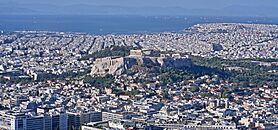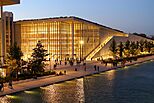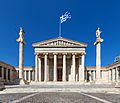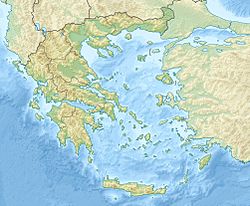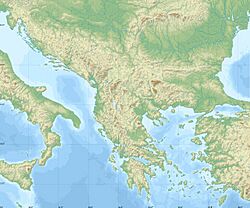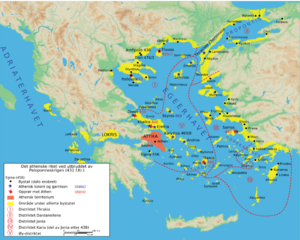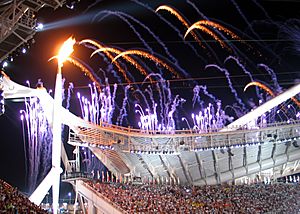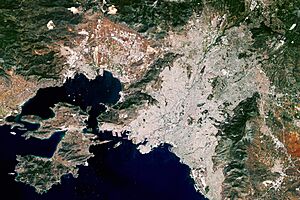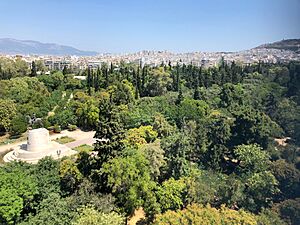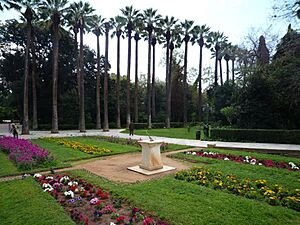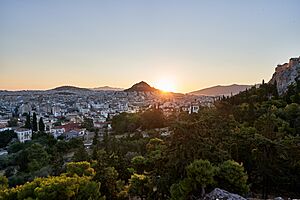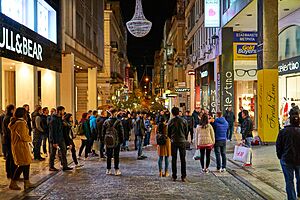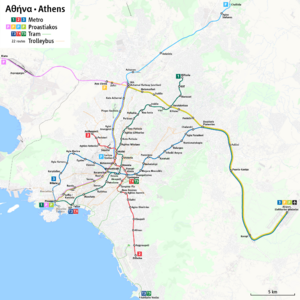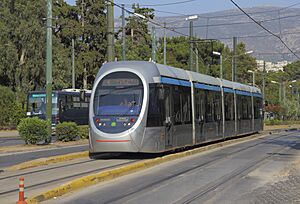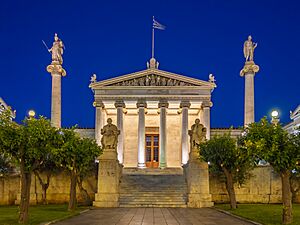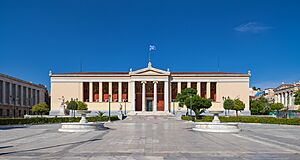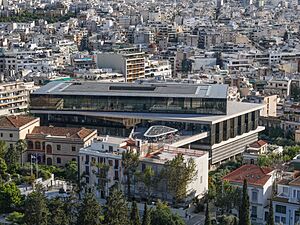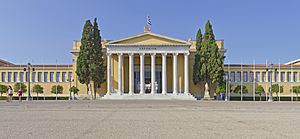Athens facts for kids
Quick facts for kids
Athens
Αθήνα
|
|||
|---|---|---|---|
|
Capital city
|
|||
|
Acropolis of Athens from Mount Lycabettus
Zappeion
Monastiraki
Metropolitan Cathedral
Old Royal Palace
(The Hellenic Parliament) Stavros Niarchos Foundation Cultural Center
Academy of Athens
|
|||
|
|||
| Nicknames:
τὸ κλεινὸν ἄστυ (tò kleinòn ásty, "the glorious city")
τὸ ἰοστεφὲς ἄστυ (tò iostephès ásty, "the violet-crowned city") The City of Wisdom City of Reason |
|||
| Country | Greece | ||
| Geographic region | Central Greece | ||
| Administrative region | Attica | ||
| Regional unit | Central Athens | ||
| Named for | Athena | ||
| Districts | 7 | ||
| Government | |||
| • Type | Mayor–council government | ||
| Area | |||
| • Capital city and municipality | 38.964 km2 (15.044 sq mi) | ||
| • Urban | 412 km2 (159 sq mi) | ||
| • Metro | 2,928.717 km2 (1,130.784 sq mi) | ||
| Highest elevation | 338 m (1,109 ft) | ||
| Lowest elevation | 70.1 m (230.0 ft) | ||
| Population
(2021)
|
|||
| • Capital city and municipality | 643,452 | ||
| • Rank | 1st urban, 1st metro in Greece | ||
| • Urban | 3,059,764 | ||
| • Urban density | 7,427/km2 (19,235/sq mi) | ||
| • Metro | 3,638,281 | ||
| • Metro density | 1,242.2781/km2 (3,217.4855/sq mi) | ||
| Demonym(s) | Athenian | ||
| GDP (Nominal) (2020) | |||
| • Total | €75.1 billion | ||
| • Per capita | €20,600 | ||
| Time zone | UTC+2 (EET) | ||
| • Summer (DST) | UTC+3 (EEST) | ||
| Postal codes |
10x xx, 11x xx, 120 xx
|
||
| Telephone | 21 | ||
| Vehicle registration | Yxx, Zxx, Ixx | ||
| Patron saint | Dionysius the Areopagite (3 October) | ||
| Major airport(s) | Athens International Airport | ||
Athens is the capital and largest city of Greece. It is a big coastal city in the Mediterranean Sea. Athens is also the capital of the Attica region and the southernmost capital on the European mainland. Over three million people live in its urban area, making it the eighth largest urban area in the European Union.
Athens is one of the world's oldest cities. People have lived here for over 3,400 years. The city's name comes from Athena, the ancient Greek goddess of wisdom. Classical Athens was a very powerful city-state in ancient Greece. It was a center for democracy, arts, learning, and philosophy. Many people see Athens as the starting point of Western civilization and the birthplace of democracy.
Today, Athens is a huge, modern city. It is important for business, money, industry, and culture in Greece. Its port, Piraeus, is one of the busiest in Europe. Athens is also home to two UNESCO World Heritage Sites: the Acropolis of Athens and the Daphni Monastery. The city has many museums, like the National Archaeological Museum. Athens hosted the first modern Olympic Games in 1896. It hosted them again in 2004.
Contents
Etymology and names
The name Athens comes from Ancient Greek. In ancient times, people debated if the city was named after the goddess Athena, or if Athena was named after the city. Most experts today believe the goddess was named after the city.
According to an old story, Athena, the goddess of wisdom, and Poseidon, the god of the seas, competed to be the city's patron. They agreed that whoever gave the best gift would win. Poseidon struck the ground with his trident, and a saltwater spring appeared. Athena offered the first domesticated olive tree. The king of Athens chose Athena's gift, making her the city's protector.
In old writings, Athens was sometimes called the "City of the Violet Crown." It was also known as "the glorious city."
History
- Kingdom of Athens 1556 BC–1068 BC
- City-state of Athens 1068 BC–322 BC
- Hellenic League 338 BC–322 BC
- Kingdom of Macedonia 322 BC–148 BC
- Roman Republic 146 BC–27 BC
- Roman Empire 27 BC–395 AD
 Eastern Roman Empire 395–1205
Eastern Roman Empire 395–1205 Duchy of Athens 1205–1458
Duchy of Athens 1205–1458 Ottoman Empire 1458–1822, 1826–1832
Ottoman Empire 1458–1822, 1826–1832 Greece 1822–present
Greece 1822–present
Ancient Times
People have lived in Athens for at least 5,000 years. Around 1400 BC, Athens became an important center of the Mycenaean civilization. The Acropolis hill was home to a large Mycenaean fortress. Unlike some other Mycenaean cities, Athens might not have been destroyed around 1200 BC.
By the 6th century BC, Athens saw many changes that led to democracy. In 508 BC, Cleisthenes helped introduce democracy. Athens became a strong naval power. It helped the Ionian cities rebel against Persian rule. In the Greco-Persian Wars, Athens and Sparta led Greek states to defeat the Persians. They won important battles at Marathon (490 BC) and Salamis (480 BC). Even so, the Persians captured and looted Athens twice in one year.
The time after these wars is known as the Golden Age of Athenian democracy. Athens became the leading city of Ancient Greece. Its cultural achievements helped shape Western civilization. Famous writers like Aeschylus, Sophocles, and Euripides lived here. Historians Herodotus and Thucydides, and the philosopher Socrates also lived in Athens.
Under Pericles, Athens built many famous structures, including the Parthenon on the Acropolis. Athens also led the Delian League, a group of Greek city-states. This league was meant to fight the Persians, but Athens used it to build its own empire. This led to the Peloponnesian War (431–404 BC), where Athens was defeated by its rival, Sparta.
By the mid-4th century BC, the kingdom of Macedon became powerful. In 338 BC, Philip II defeated Athens and other Greek city-states. Later, under Roman rule, Athens was a "free city" because of its famous schools. The Roman emperor Hadrian, who was an Athenian citizen, built many things in the 2nd century AD. These included a library, a gym, and an aqueduct that is still used today.
In the early 4th century AD, the Eastern Roman Empire was ruled from Constantinople. Many artworks from Athens were moved there. The empire became Christian, and Athens became less important. Ancient buildings like the Parthenon were turned into churches. Athens was attacked by the Herules in 267 AD and by the Visigoths in 396 AD. Emperor Justinian I banned pagan philosophy in 529 AD, which marked the end of ancient Athens.
Middle Ages
Athens was threatened by Saracen raids in the 8th and 9th centuries. In the 11th and 12th centuries, the city grew quickly. It became a center for making soaps and dyes. Traders from Venice and other places came to Athens, which helped its economy. Many important churches were built during this time.
In 1204, the Fourth Crusade conquered Athens. The city was ruled by "Latins" (Western Europeans) until 1458. This period is known as the Frankokratia.
Ottoman Rule
The Ottomans first attacked Athens in 1397. In 1458, Sultan Mehmed II captured the city. He was impressed by its ancient buildings and ordered them not to be destroyed. The Parthenon was turned into the main mosque of the city.
Under Ottoman rule, Athens became a small town. The Ottomans stored gunpowder in the Parthenon. In 1687, during a war, the Venetians attacked the Acropolis. A shot hit the Parthenon's gunpowder storage, causing a huge explosion. This severely damaged the building, giving it the look it has today.

Modern History
In 1822, Greek rebels captured Athens during the Greek War of Independence. But the Ottomans took it back in 1826. The ancient monuments were damaged again. The Ottomans left in 1833.
In 1834, Athens became the capital of the newly independent Greek Kingdom. At that time, it was a small town of about 4,000 people. The first King of Greece, King Otto, hired architects to design a modern city. They planned a city that connected the Acropolis, the ancient cemetery, and the new royal palace. This showed the link between modern and ancient Athens.

In 1896, Athens hosted the first modern Olympic Games. In the 1920s, many Greek refugees from Asia Minor moved to Athens, making its population grow. After World War II, the city's population exploded, and Athens expanded greatly.
By the 1980s, pollution from factories and cars became a big problem. In the 1990s, the city took steps to reduce pollution. They also improved the city's infrastructure, like building the Attiki Odos motorway and expanding the Athens Metro. These changes made Athens a much more functional city. In 2004, Athens hosted the 2004 Summer Olympics again.
Geography
Athens is located on a plain called the Athens Basin. This basin is surrounded by four large mountains: Mount Aigaleo to the west, Mount Parnitha to the north, Mount Pentelicus to the northeast, and Mount Hymettus to the east. The Saronic Gulf is to the southwest. Mount Parnitha is the tallest mountain and is a national park.
Athens has many hills. Lycabettus is one of the tallest hills in the city and offers great views. Athens' weather can be tricky because the mountains trap air, causing pollution. This is similar to cities like Los Angeles. The main rivers in Athens are the Cephissus, the Ilisos, and the Eridanos.
Environment
In the late 1970s, pollution in Athens was very bad. It was damaging ancient statues. But measures taken in the 1990s improved air quality. Smog, which Athenians called nefos, is now less common.
However, air pollution is still a problem, especially on hot summer days. In 2007, wildfires burned a large part of the national park on Mount Parnitha. This caused worries about air quality.
Efforts in waste management, like a plant on Psytalia island, have made the water in the Saronic Gulf much cleaner. Now, people can swim in the coastal waters of Athens again.
Parks and Zoos
Parnitha National Park has many paths, gorges, and caves. Hiking and mountain biking are popular activities for city residents. The National Garden of Athens was finished in 1840. It is a green space of 15.5 hectares in the city center. It is located between the Parliament and Zappeion buildings.
Parts of the city center have been improved. The Dionysiou Areopagitou Street is now a walking path. It starts from the Temple of Olympian Zeus and goes past the Acropolis and Plaka. It ends near the Temple of Hephaestus in Thiseio. This path offers views of the Parthenon and the Agora.
The hills of Athens also provide green spaces. Lycabettus, Philopappos hill, and the area around them are covered with trees. The Pedion tou Areos park is 27.7 hectares and is near the National Archaeological Museum.
Athens' largest zoo is the Attica Zoological Park. It is a 20-hectare private zoo in the suburb of Spata. It has about 2000 animals from 400 species. Smaller zoos are found in public gardens, like the National Garden.
Climate
Athens has a hot-summer Mediterranean climate. This means it has hot, dry summers and mild, wet winters. The city center has an average temperature of 19.2°C (66.6°F). Athens gets about 433.1 mm (17 inches) of rain each year. Most of the rain falls in the colder months. Fog is rare in the city center.
The southern parts of Athens, like Elliniko and the Athens Riviera, have slightly different weather. Their climate is affected by the Saronic Gulf, making temperature changes less extreme. The northern parts of the city, like Kifissia, are higher up. They have cooler temperatures and a bit more rain.
Snowfall is not very common, but it happens almost every year. It usually does not cause big problems in daily life. However, the northern parts of the city can get more snowstorms. For example, there were big snowstorms in February 2021 and January 2022.
Summers in Athens can be very hot. This is partly because of the "urban heat island" effect, where cities get hotter than surrounding areas. Athens is considered the hottest city in mainland Europe. It was the first city in Europe to appoint a chief heat officer to deal with severe heat waves. Temperatures of 47.5°C (117.5°F) have been recorded in some parts of the city.
Administration
Athens became the capital of Greece in 1834. The city of Athens is also the capital of the Attica region. The term Athens can mean the Municipality of Athens, the larger urban area, or the entire Athens Metropolitan Area.
The Municipality of Athens is the city center. It is the most populated municipality in Greece. Piraeus is another important city center within the Athens Urban Area.
Athens Urban Area
The Athens Urban Area is also known as Greater Athens. It includes 40 municipalities. These are divided into four regional units: North Athens, West Athens, Central Athens, and South Athens. It also includes five municipalities from the Piraeus regional unit.
The Municipality of Athens is the core of Greater Athens. Greater Athens has a population of 3,059,764 people (in 2021) and covers 412 square kilometers. This entire area is usually what people mean when they say "Athens." It is the largest urban area in Greece.
|
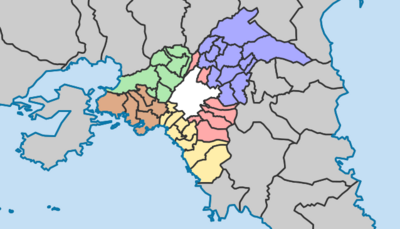 |
Athens Metropolitan Area
The Athens metropolitan area is even larger. It covers 2928.717 square kilometers within the Attica region. It includes 58 municipalities and had a population of 3,638,281 in 2021. This area covers almost the entire Attica peninsula.
The municipalities around the city center are called suburbs. They are divided into four zones:
- Northern suburbs: These include places like Kifissia, Maroussi, and Chalandri.
- Southern suburbs: These include Alimos, Piraeus, Glyfada, and Voula.
- Eastern suburbs: These include Zografou, Vyronas, and Kaisariani.
- Western suburbs: These include Peristeri, Ilion, and Egaleo.
The Athens coastline stretches for about 25 kilometers from Piraeus to Varkiza. It is connected to the city center by tram. Many southern suburbs, like Glyfada and Vouliagmeni, have sandy beaches.
In the northern suburb of Maroussi, the Athens Olympic Sports Complex (OAKA) was updated for the 2004 Olympics. It has a new blue glass roof and landscaped gardens. The old Athens Airport, called Elliniko, is being turned into one of Europe's largest parks.
Twin towns – sister cities
Athens has many "partner cities" around the world. These are cities in different countries that work together and help each other.
Economy
Athens is the financial capital of Greece. In 2014, the Athens metropolitan area produced about US$130 billion in goods and services. This was almost half of what the whole country produced. Athens is a major economic center in Southeastern Europe.
Important Greek companies like Hellas Sat and Hellenic Petroleum have their main offices in Athens. Many international companies, such as Ericsson and Microsoft, also have offices here. The banking sector is strong, with major banks like National Bank of Greece located in the city.
Tourism is a big part of Athens' economy. It is one of Europe's top destinations for city breaks. Greece welcomed over 33 million visitors in 2018. Athens alone had more than 5 million tourists that year. The city's infrastructure has improved a lot, partly because of the 2004 Olympic Games. Projects like the Athens International Airport, the expanded Athens Metro, and the new Attiki Odos Motorway have helped.
Transport
Athens is Greece's main transportation hub. It has the country's largest airport and largest port, Piraeus. Piraeus is also the largest container port in the Mediterranean.
Public transport in Athens includes buses, trolleybuses, the Metro, a Suburban Railway, and a tram network. These connect the southern suburbs to the city center.
Bus Transport
OSY operates buses and trolleybuses in Athens. As of 2017, there were about 322 bus lines and 2,375 buses and trolleybuses. Many of these buses run on natural gas, making it one of the largest fleets of natural gas-powered buses in Europe.
Railways
Athens is the center of Greece's national railway system. It connects the capital with major cities in Greece and other countries.
The Athens Suburban Railway, called Proastiakos, connects Athens International Airport to the city of Kiato. It also connects to Larissa station, the city's main train station, and the port of Piraeus.
The Athens Metro has three lines. Line 1 was built in 1869. Lines 2 and 3 were built mostly in the 1990s. The Metro helps over 1.3 million passengers travel each day. The new stations completed in 2022 connect the Port of Piraeus with Athens International Airport.
The Athens Tram has 48 stations and covers 10 suburbs. It runs from Syntagma Square to the southwestern suburb of Palaio Faliro. From there, it splits into two branches: one goes along the coast to Voula, and the other goes to Piraeus.
Athens International Airport
Athens is served by the Athens International Airport (ATH). It is located near the town of Spata, about 35 kilometers (22 miles) east of the city center. The airport was built in 51 months and cost 2.2 billion euros. It is a major hub for air travel in southeastern Europe.
Ferry
The Port of Piraeus is the largest port in Greece. It connects Athens with many Greek islands in the Aegean Sea. Rafina and Lavrio are other ports that serve Athens.
Motorways
Two main motorways start in Athens. The A1/E75 goes north towards Thessaloniki. The A8/E94 goes west towards Patras.
The Attiki Odos is a toll motorway network that serves Athens. Its main part, the A6, goes from Elefsina to Athens International Airport. Two other parts, the Aigaleo Beltway and the Hymettus Beltway, serve western and eastern Athens. The Attiki Odos is 65 kilometers (40 miles) long, making it the largest metropolitan motorway network in Greece.
Education
On Panepistimiou Street, you can find the old campus of the University of Athens, the National Library, and the Athens Academy. These three buildings are known as the "Athens Trilogy."
The largest and oldest university in Athens is the National and Kapodistrian University of Athens. Many of its functions have moved to a campus in Zografou. The National Technical University of Athens also has an old campus on Patision Street.
The University of West Attica is the second largest university in Athens. Other universities in Athens include the Athens University of Economics and Business, the Panteion University, and the Agricultural University of Athens. There are also several private colleges in Athens.
Culture
Archaeological Sites and Museums
Athens is a world center for archaeological research. It has many archaeological museums. These include the National Archaeological Museum, the Cycladic Museum, and the Acropolis Museum.
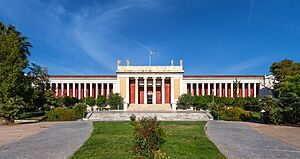
The National Archaeological Museum is the largest archaeological museum in Greece. It has a huge collection of ancient items, covering over 5,000 years of history. The New Acropolis Museum, opened in 2009, is very popular. Almost a million people visited it in just a few months after it opened.
Other important museums in Athens include:
- The Benaki Museum, which has collections of ancient, Byzantine, Ottoman, and Chinese art.
- The Byzantine & Christian Museum, which has important Byzantine art.
- The National Art Gallery, which reopened in 2021 after being renovated.
- The National Museum of Contemporary Art, which opened in 2000.
- The Numismatic Museum, which has a large collection of ancient and modern coins.
- The Museum of Cycladic Art, known for its white marble figurines.
- The Kerameikos Archaeological Museum, which shows items from the Kerameikos burial site.
- The Jewish Museum of Greece, which tells the history and culture of the Greek Jewish community.
Architecture
Athens has many different architectural styles. These range from Greco-Roman and Neoclassical to Modern. You can often see different styles in the same area. There are strict rules about building height in Athens. This is to make sure the Acropolis Hill can be seen from all over the city.
In the 19th century, Neoclassicism was very popular. The Old Royal Palace was one of the first important public buildings built in this style. Architects like Theophil Freiherr von Hansen and Ernst Ziller designed many neoclassical buildings. These include the Athens Academy and the Zappeion Hall.
In the 1920s, modern styles like Bauhaus and Art Deco became popular. Many new buildings were built in these styles. After World War II, the city center was largely rebuilt. Architects like Walter Gropius designed buildings in the International style.
Entertainment and Performing Arts
Athens has 148 theaters, more than any other city in the world. The ancient Odeon of Herodes Atticus hosts the Athens Festival every year. The city also has many outdoor cinemas and music venues like the Athens Concert Hall. The Athens Planetarium is one of the largest and best-equipped digital planetariums in the world.
The Stavros Niarchos Foundation Cultural Center, opened in 2016, is home to the National Library of Greece and the Greek National Opera. In 2018, Athens was named the World Book Capital by UNESCO.
You can find restaurants, tavernas, and bars in areas like Plaka and Monastiraki. The inner suburbs of Gazi and Psyrri are known for nightclubs and bars. Coastal suburbs like Microlimano and Glyfada have many tavernas and beach bars.
In the early 1900s, Athenian serenades and theatrical songs were popular. After 1922, many Greek refugees came to Athens. They brought Rebetiko music, which became popular and later influenced Laïko music. Famous Greek composers like Manos Hadjidakis and Mikis Theodorakis are known for their film scores.
The famous American-born Greek singer Maria Callas spent her teenage years in Athens. Her opera career started there in 1940. In 2018, the city's Olympia Theatre was renamed "Olympia City Music Theatre 'Maria Callas'." In 2023, the Maria Callas Museum opened in Athens.
Sports
Athens has a long history in sports. It is home to Greece's most important sports clubs and many sports facilities. The city has hosted major international sports events.
Athens has hosted the Summer Olympic Games twice: in 1896 and 2004. The 2004 Olympics led to the development of the Athens Olympic Stadium. This stadium is now known as one of the most beautiful in the world. It has hosted two UEFA Champions League finals. Other major stadiums include the Karaiskakis Stadium in Piraeus and Agia Sophia Stadium in Nea Filadelfeia.
Athens is home to three big multi-sport clubs: Panathinaikos, Olympiacos, and AEK Athens. In football, Panathinaikos reached the 1971 European Cup Final. Olympiacos has won many national titles. AEK Athens is also a strong team. These clubs also have basketball teams. Panathinaikos and Olympiacos are among the best basketball teams in Europe.
The Athens area has many hills and mountains. These offer thousands of kilometers of trails for hiking and mountain biking. Beyond Athens, you can also enjoy skiing, rock climbing, hang gliding, and windsurfing.
Athens won the bid to host the 2004 Summer Olympics on September 5, 1997. It was the second time Athens would host the Games. Even though it cost a lot, Athens became a more modern and functional city. The Games welcomed over 10,000 athletes from 202 countries.
Images for kids
-
The second Parthenon mosque in the ruined Parthenon, destroyed in 1687.
See also
 In Spanish: Atenas para niños
In Spanish: Atenas para niños


